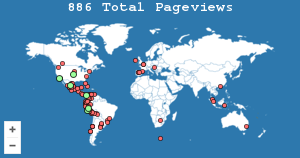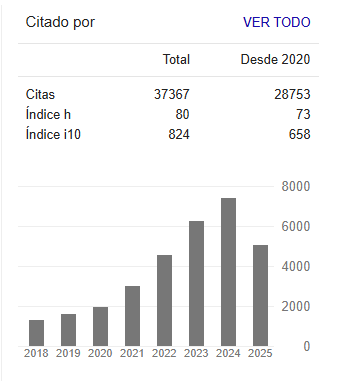Transformación digital para la competitividad de las empresas
Abstract
La transformación digital es un proceso tanto tecnológico como sociocultural que involucra la adopción de tecnologías digitales y modificaciones en los modelos de negocio y la estrategia de las firmas. La literatura que estudia relaciones entre la transformación digital y la competitividad de las empresas se incrementó en el periodo de postpandemia, sin embargo, las investigaciones antes de la pandemia son escasas, por lo cual el objetivo de esta investigación es analizar el efecto de la transformación digital en la competitividad de las empresas antes de esta crisis. Los datos que se utilizaron para el análisis son de las Encuestas Nacionales sobre Productividad y Competitividad de las Pymes en Sectores Estratégicos en México. El análisis se realizó en dos partes: I. geoestadístico para buscar clústeres geográficos de corte natural y II. estadístico mediante la regresión Ridge. Los resultados evidenciaron que tanto la transformación digital como la competitividad se distribuyen de manera desigual en los territorios; sin embargo, se encontró un efecto positivo de la transformación digital en la competitividad de estas. De acuerdo con lo anterior, se concluyó que las empresas que quieran aumentar su competitividad deben incrementar su transformación digital, por lo que los gobiernos deben continuar estableciendo políticas y programas de transformación digital en todos los sectores y en forma más equitativa.
References
Almeida, F., Duarte Santos, J., & Augusto Monteiro, J. (2020). The Challenges and Opportunities in the Digitalization of Companies in a Post-COVID-19 World. IEEE Engineering Management Review, 48(3), 97-103. https://doi.org/10.1109/EMR.2020.3013206.
Anselin, L., Syabri, I., & Kho, Y. (2006). GeoDa: An Introduction to Spatial Data Analysis. Geographical Analysis, 38(1), 5-22.
Babar, Z., & Yu, E. (2015). Enterprise architecture in the age of digital transformation. Lecture Notes in Business Information Processing, 215.
Barker, L. E., & Shaw, K. M. (2015). Best (but oft-forgotten) practices: Checking assumptions concerning regression residuals1,2. American Journal of Clinical Nutrition, 102(3), 533-539. https://doi.org/10.3945/ajcn.115.113498
Belsley, D. (1991). Conditioning diagnostics: Collinearity and weak data in regression. John Wiley & Sons.
Bergman-Rosamond, A., Gammeltoft-Hansen, T., Hamza, M., Hearn, J., Ramasar, V., & Rydstrom, H. (2022). The case for Interdisciplinary Crisis Studies. Global Discourse, 12(3-4), 465-486. https://doi.org/10.1332/204378920X15802967811683
Bharadwaj, A., El Sawy, O. A., Pavlou, P. A., & Venkatraman, N. (2013). Digital Business Strategy: Toward a Next Generation of Insights. MIS Quarterly, 37(2), 471-482.
Bienhaus, F., & Haddud, A. (2018). Procurement 4.0: Factors influencing the digitisation of procurement and supply chains. Business Process Management Journal, 24(4).
Bogers, M., Chesbrough, H., & Moedas, C. (2018). Open innovation: Research, practices, and policies. California Management Review, 60(2).
Breusch, T. S., & Pagan, A. R. (1979). A Simple Test for Heteroscedasticity and Random Coefficient Variation. Econometrica, 47(5), 1287–1294. https://doi.org/10.2307/1911963
Camisón, C., & Villar-López, A. (2011). Non-technical innovation: Organizational memory and learning capabilities as antecedent factors with effects on sustained competitive advantage. Industrial Marketing Management, 40(8), 1294-1304. https://doi.org/10.1016/j.indmarman.2011.10.001.
CEPAL. (2021). Transformación digital de las mipymes:elementos para el diseño de políticas. Comisión Económica para América Latina y el Caribe.
Chen, Y. Lin, M. y Chang, C. (2009). The positive effects of relationship learning and absorptive capacity on innovation performance and competitive advantage in industrial markets. Industrial marketing management, 38 (2) pp. 152-158.
Cozzolino, A., Verona, G., & Rothaermel, F. T. (2018). Unpacking the disruption process: New technology, business models, and incumbent adaptation. Journal of Management Studies, 55(7).
Daft, R. L., Becker, S.W., Selwyn, W., (1978). The Innovative Organization: Innovation Adoption in School Organizations. Elsevier.
Dwivedi, Y. K., Hughes, D. L., Coombs, C., Constantiou, I., Duan, Y., Edwards, J. S., Gupta, B., Lal, B., Misra, S., Prashant, P., Raman, R., Rana, N. P., Sharma, S. K., & Upadhyay, N. (2020). Impact of COVID-19 pandemic on information management research and practice: Transforming education, work and life. International Journal of Information Management, 55, 102211. https://doi.org/10.1016/j.ijinfomgt.2020.102211
Fisher, W. D. (1958). On Grouping for Maximum Homogeneity. Journal of the American Statistical Association, 53(284), 789. https://doi.org/10.2307/2281952
Google (2024). Google Colab. https://colab.research.google.com/
Griliches, Z. (1990). Patent statistics as economic indicators: A survey. Journal of Economic Literature, 28(4), 1661. https://doi.org/10.1257/jel.28.4.1661
Hagedoorn, J., & Cloodt, M. (2003). Measuring innovative performance: is there an advantage in using multiple indicators? Research Policy, 32(8), 1365–1379. https://doi.org/10.1016/s0048-7333(02)00137-3
Hair, J. F., Black, W. C., Babin, B. J., & Anderson, R. E. (2019). Multivariate data analysis (8th ed.). Cengage Learning.
Hao, F., Xiao, Q., & Chon, K. (2020). COVID-19 and China’s hotel industry: Impacts, a disaster management framework, and post-pandemic agenda. International Journal of Hospitality Management, 90(102636), 102636. https://doi.org/10.1016/j.ijhm.2020.102636
Hess, T., Matt, C., Benlian, A., & Wiesböck, F. (2016). Options for formulating a digital transformation strategy. MIS Quarterly Executive, 15(2), 123e139.
Hoerl, A. E., & Kennard, R. W. (1970). Ridge Regression: Biased Estimation for Nonorthogonal Problems. Technometrics, 12(1), 55–67. https://doi.org/10.2307/1267351
Hunter, J. D. (2007). Matplotlib: A 2D Graphics Environment. Computing in Science & Engineering, 9(3), 90-95.
Iivari, N., Sharma, S., & Ventä-Olkkonen, L. (2020). Digital transformation of everyday life – How COVID-19 pandemic transformed the basic education of the young generation and why information management research should care? International Journal of Information Management, 55, 102183. https://doi.org/10.1016/j.ijinfomgt.2020.102183.
INEGI (2015). Encuesta Nacional sobre Productividad y Competitividad de las Micro, Pequeñas y Medianas Empresas 2015 (ENAPROCE). INEGI. https://www.inegi.org.mx/contenidos/productos/prod_serv/contenidos/espanol/bvinegi/productos
INEGI (2018). Encuesta Nacional sobre Productividad y Competitividad de las micro, pequeñas y medianas Empresas 2018 (ENAPROCE). https://www.inegi.org.mx/contenidos/productos/prod_serv/contenidos/espanol/bvinegi/productos
James, G., Witten, D., Hastie, T., & Tibshirani, R. (2013). An Introduction to Statistical Learning: with Applications in R. Springer Science & Business Media.
Jenks, G. (1977). Optimal Data Classification for Choropleth Maps. Occasional. Paper no. 2. University of Kansas.
Jessop, B., & Knio, K. (Eds.). (2018). The pedagogy of economic, political and social crises: Dynamics, construals and lessons. Routledge.
Kamalaldin, A., Linde, L., Sjödin, D., & Parida, V. (2020). Transforming provider-customer relationships in digital servitization: A relational view on digitalization. Industrial Marketing Management, 89. https://doi.org/10.1016/j.indmarman.2020.02.004.
Kane, G., Palmer, D., Phillips, A., Kiron, D. & Buckley, N. (2015) Strategy, not Technology, Drives Digital Transformation: Becoming a Digitally Mature Enterprise. MIT Sloan Review.
Kenney, M., Rouvinen, P., & Zysman, J. (2015). The Digital Disruption and its Societal Impacts. Journal of Industry Competition and Trade, 15(1), 1–4. https://doi.org/10.1007/s10842-014-0187-z
Kolaczyk, E. D., & Csárdi, G. (2014). Statistical analysis of network data with R. Springer.
Lanjouw, J. O., & Schankerman, M. (1997). Characteristics of patent litigation: A window on competition. The RAND Journal of Economics, 28(1), 129-151. https://doi.org/10.2307/2555762
Leão, P., & da Silva, M. M. (2021). Impacts of digital transformation on firms’ competitive advantages: A systematic literature review. Strategic Change, 30(5), 421–441. https://doi.org/10.1002/jsc.2459
Llopis-Albert, C., Rubio, F., & Valero, F. (2021). Impact of digital transformation on the automotive industry. Technological Forecasting and Social Change, 162. https://doi.org/10.1016/j.techfore.2020.120343.
Loebbecke, C., & Picot, A. (2015). Reflections on societal and business model transformation arising from digitization and big data analytics: A research agenda. Journal of Strategic Information Systems, 24(3), 149–157. https://doi.org/10.1016/j.jsis.2015.08.002
Mardia, K. V. (1970). Measures of multivariate skewness and kurtosis with applications. Biometrika, 57(3), 519. https://doi.org/10.2307/2334770
Nasiri, M., Ukko, J., Saunila, M., & Rantala, T. (2020). Managing the digital supply chain: The role of smart technologies. Technovation, 96–97(102121), 102121. https://doi.org/10.1016/j.technovation.2020.102121
Pedregosa, F., Varoquaux, Gael, Gramfort, A., Michel, V., Thirion, B., Grisel, O. (2011). Scikit-learn: Machine learning in Python. Journal of Machine Learning Research, 12(Oct), 2825–2830.
Porter, M.E. (1985). Competitive Advantage. Creating and Sustaining Superior Performance. The Free Press, New York.
Porter, M.E. (1990). The Competitive Advantage of Nations. The Free Press.
Rapaccini, M., Saccani, N., Kowalkowski, C., Paiola, M., & Adrodegari, F. (2020). Navigating disruptive crises through service-led growth: The impact of COVID-19 on Italian manufacturing firms. Industrial Marketing Management, 88. https://doi.org/10.1016/j.indmarman.2020.05.017
Reforma (2023). Declara OMS fin de emergencia mundial por Covid-19. https://www.reforma.com/declara-oms-fin-de-emergencia-mundial-por-covid-19/ar2599663
Saarikko, T., Westergren, U. H., & Blomquist, T. (2020). Digital transformation: Five recommendations for the digitally conscious firm. Business Horizons, 63(6), 825-839. https://doi.org/10.1016/j.bushor.2020.07.005.
Saavedra, M. (2012). Una propuesta para la determinación de la competitividad en la pyme latinoamericana. Pensamiento y gestión, (33), 93-124. https://rcientificas.uninorte.edu.co/index.php/pensamiento/article/view/4898
Salgado-García, J. A., Terán-Bustamante, A., & González-Zelaya, V. (2024). Digital transformation in management and accounting sciences: Research trends in Scopus. Iberoamerican Journal of Science Measurement and Communication, 4(1), 1–10. https://doi.org/10.47909/ijsmc.884
Schumpeter, J. (1934). Theory of Economic Development. Cambridge.
Schumpeter, J. A. (1942). The Process of Creative Destruction In Capitalism, Socialism and Democracy. Ed. J. Schumpeter, pp. 81–86.
Schwarzmüller, T., Brosi, P., Duman, D., & Welpe, I. M. (2018). How does the digital transformation affect organizations? Key themes of change in work design and leadership. Management-Revue, 29(2), 114–138. https://doi.org/10.5771/0935-9915-2018-2-114
Shapiro, S. S., & Wilk, M. B. (1965). An Analysis of Variance Test for Normality (Complete Samples). Biometrika, 52(3/4), 591–611. https://doi.org/10.2307/2333709
Sui, X., Jiao, S., Wang, Y., & Wang, H. (2024). Digital transformation and manufacturing company competitiveness. Finance Research Letters, 59. https://doi.org/10.1016/j.frl.2023.104683
Teece, D. J. (2007). Explicating dynamic capabilities: the nature and microfoundations of (sustainable) enterprise performance. Strategic Management Journal, 28(13), 1319–1350. https://doi.org/10.1002/smj.640
Tidd, J. & Bessant, J. (2009). Managing innovation: Integrating technological, market and organizational change. Wiley.
Varouchakis, E. A. (2019). Geostatistics. En Spatiotemporal Analysis of Extreme Hydrological Events (pp. 1–38). Elsevier.
Weinman, J. (2015). Digital disciplines: Attaining market leadership via the cloud, big data, social, mobile, and the internet of things. Wiley.
White, H. (1980). A Heteroskedasticity-Consistent Covariance Matrix Estimator and a Direct Test for Heteroskedasticity. Econometrica: journal of the Econometric Society, 48(4), 817. https://doi.org/10.2307/1912934
WHO (2020). Who Timeline - COVID-19. https://www.who.int/news-room/detail/27-04-2020-who-timeline---covid-19
Zheng, Y., & Zheng, S. (2022). A comparison of students’ learning behaviors and performance among pre, during and post COVID-19 pandemic. Proceedings of the 23rd Annual Conference on Information Technology Education.

This work is licensed under a Creative Commons Attribution-NonCommercial-ShareAlike 4.0 International License.








.png)






























